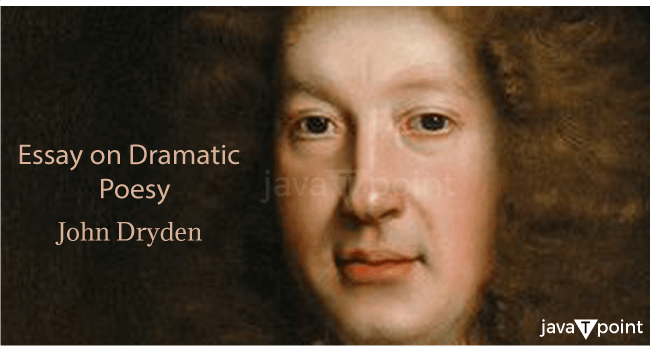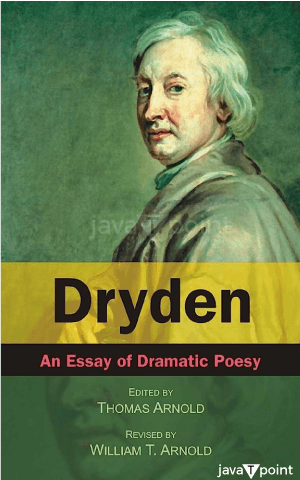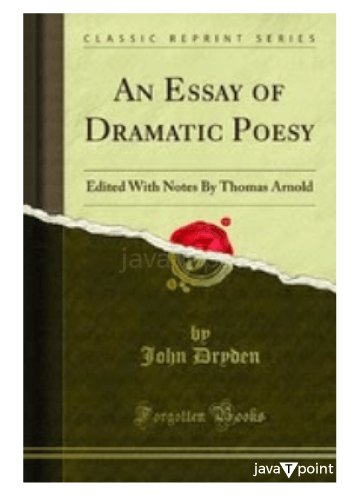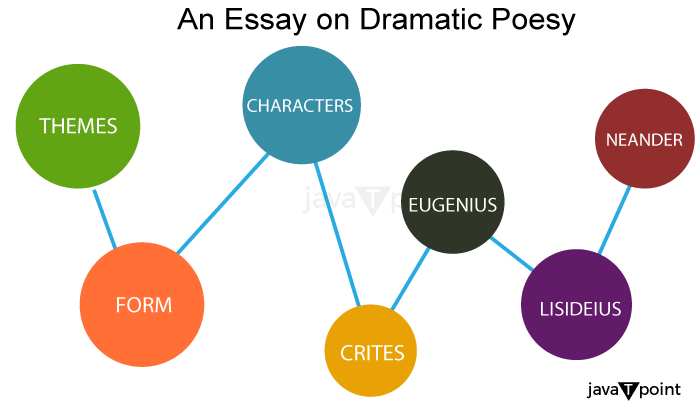An Essay of Dramatic Poesy Summary by John DrydenJohn Dryden published a critique titled "An Essay of Dramatic Poesy" in 1668. It discusses drama and the defence of English theatre against the French critics' neoclassical guidelines. Three of Dryden's pals and he had a passionate conversation about various facets of dramatic poetry. Four characters which are Eugenius, who stands in for Dryden himself, Crites, who represents Sir Robert Howard, Lisideius, who represents Sir Charles Sedley and Neander, who represents Dryden's friend Sir William Davenant converse in the essay. Each character shares their perspectives on dramatic poetry and gets into a heated discussion, showing the popular viewpoints at the time. 
Through these characters, Dryden examines several important dramatic topics and contentions. He argues that the English stage allows for more variation and originality, unlike the French neoclassicists' rigorous commitment to the unities of time, place, and action. Additionally, Dryden discusses the usage of verse as opposed to prose in plays, stating that he prefers verse as a more refined and appropriate mode for dramatic expression. In addition, Dryden explores the advantages of tragicomedy over pure tragedy, a genre that contains elements of both. He assesses the qualities and shortcomings of historical playwrights' works, especially Shakespeare, and contrasts them with modern French playwrights like Pierre Corneille and Jean Racine. In his essay, Dryden argues for a more lenient view of theatrical norms and praises the brilliance of English playwrights in proving the legitimacy and worth of English drama. An important piece of English literary criticism, "An Essay of Dramatic Poesy," influenced the understanding and growth of dramatic art throughout the Restoration era. Literary Landscape's Background and ContextTo fully appreciate and comprehend "An Essay of Dramatic Poesy," it is crucial to grasp the academic environment and social setting in which John Dryden wrote this important piece. The essay was composed in England between 1660 and 1688, during the Restoration era. Following a time of political unrest and Oliver Cromwell's puritanical administration, the monarchy was restored during this century under the leadership of King Charles II. Dramatic production flourished after the monarchy was restored due to a resurgence in interest in the arts and literature. French neoclassical ideas significantly impacted literary and artistic circles during this period. The gold standard for French play originated from the works of Pierre Corneille and Jean Racine. The rigid rules, such as the unities of time, location, and action, as outlined by the ancient Greek philosopher Aristotle, were highlighted by French critics. These guidelines sought to guarantee a play's reasonability, decency, and cohesion. English play, particularly William Shakespeare's works, adopted a more adaptable and innovative approach than the French neoclassical style. Shakespeare's plays frequently combined tragic and humorous themes, alternated between poetry and prose, and were set in various places and eras. These traits, however, ran counter to the neoclassical principles promoted by French critics. Dryden's View of Dramatic PoetryJohn Dryden offers several significant ideas and justifications that help to build his viewpoint on dramatic poetry in "An Essay of Dramatic Poesy." His defence of English play against the stringent neoclassical guidelines promoted by French critics can be seen in these themes and arguments. Following are some of Dryden's primary points and justifications: 1. Diversity and LibertyAccording to Dryden, English play offers more diversity and freedom than French neoclassicism, which adheres to strict guidelines. He claims that a wide range of genres, such as tragedy, comedy, tragicomedy, and masque, are represented on the English stage, giving audiences a more varied and enjoyable experience. 
2. Unity of Time, Place, and ActionFollowing the neoclassical tradition, Dryden debates the unities of time, place, and action. Although he acknowledges their significance, he critiques their rigorous adherence, contending that it constricts a play's potential for creativity and scope. According to Dryden, dramatic works should span a wider period and occur in various settings as long as they still preserve a strong narrative. 3. Verse Vs. ProseDryden discusses the employment of verse and prose in dramatic poetry. He contends that the grandeur and high emotions necessary for tragedy are better served by the verse's elevated vocabulary and rhythmic features. However, he also appreciates how well prose, particularly in comedy, can capture human life's real and ordinary features. In his balanced approach, Dryden suggests that verse and prose can coexist and both meet the demands of the drama. 4. TragicomedyDryden likes the tragicomedy genre, which blends aspects of comedy and tragedy. He thinks that tragicomedy balances the sad and the humorous, enabling a more interesting and accurate depiction of human existence. According to Dryden, a pure tragedy can be overwhelming and lack the diversity and depth seen in a sad comedy. 5. Evaluation of ShakespeareShakespeare's works are evaluated severely by Dryden, regarded as the greatest dramatist in English history. Shakespeare's brilliance and dramatic impact are acknowledged, but Dryden also identifies Shakespeare's shortcomings. He criticizes Shakespeare for ignoring the unities and using too much wordplay. However, Dryden recognizes Shakespeare's works' emotional resonance and applicability to all cultures, making him an important figure in the evolution of English play. These topics and arguments reveal Dryden's viewpoint on dramatic poetry as he supports a more adaptable and creative approach to theatrical norms while defending the virtues of English play. To create the foundation for a distinctive English dramatic tradition, Dryden tries to prove English theater's legitimacy and artistic value through his essay. Characters and Their ViewsIn his poem "An Essay of Dramatic Poesy," John Dryden creates an imaginary conversation between four individuals, each representing a distinct viewpoint on dramatic poetry. These characters get into a heated argument, exhibiting differing viewpoints on numerous theatre-related topics. The opinions of the four critics are listed below: 1. EugeniusEugenius serves as the essay's main voice and reflects Dryden personally. He makes an argument in favour of English drama's creative freedom. Eugenius argues for the English stage in opposition to the rigid French critics' neoclassical guidelines. He supports the notion that English drama offers a greater range of genres, including tragedy, comedy, and tragicomedy, by highlighting its diversity and freedom. Eugenius advocates the idea that English theatre can create compelling and potent works. 2. CritesThe character Crites represents Sir Robert Howard, a writer, and critic of the period. Crites adopts a more cautious attitude about English drama's inadequacies than the French neoclassical tradition. He contends that the French theatre represents a more sophisticated and structured approach to dramatic poetry due to its devotion to the unities and emphasis on logic. Although Crites recognizes the shortcomings of English plays, such as their loose adherence to the unities, he also sees room for growth. 
3. LisideiusThe writer and poet Sir Charles Sedley is represented by Lisideius. Lisideius extols the rigid neoclassical guidelines and defends French play. He contends that the French theater corresponds to Aristotle's ideas and is the pinnacle of reason and beauty, especially in the works of Pierre Corneille and Jean Racine. According to Lisideius, English plays need more consistency and unity, while the French tradition offers a more disciplined and sophisticated method of creating dramatic art. 4. NeanderNeander depicts Sir William Davenant, a poet, dramatist, and theatre director who was Dryden's acquaintance. Neander adopts a more impartial viewpoint, attempting to reconcile the French and English cultural traditions. He recognizes the strengths, valuing the variety and freedom of English play and the structure and coherence of French theatre. Neander contends that more strong and potent dramatic poetry can be produced by combining the best elements of the two traditions. Dryden gives a variety of opinions on dramatic poetry through the discussion between these four critics, allowing readers to interact with various viewpoints and arguments. This tool thoroughly examines the prevailing viewpoints and arguments on theatre throughout the Restoration era. Comparing French and English TraditionsJohn Dryden vehemently defends English play against the rigid neoclassical standards in "An Essay of Dramatic Poesy," praising the advantages of the English theatrical tradition. He contrasts and compares the differences between English and French drama, emphasizing the distinct features and advantages of each. The following are some crucial arguments in favour of English play and a comparison to the French tradition: 1. Freedom and VarietyIn contrast to the French neoclassical tradition, English play, according to Dryden, offers more freedom and diversity. He applauds the English theatre for featuring a variety of genres, such as tragedy, comedy, tragicomedy, and masque. According to Dryden, this diversity offers spectators a richer tapestry of human emotions and experiences, making for a more interesting and enjoyable encounter. 2. Creative LibertiesDryden underlines the artistic freedom that English playwrights are afforded. He laments the rigid devotion to the unities of time, location, and action in French theatre, contending that it constricts the play's potential for artistic expression. The ability to cover more time and places and include subplots afforded to English writers, on the other hand, allows for a more expansive and lifelike depiction of the human condition. 3. Naturalness and RealismDryden lauds English theatre for its portrayal of persons and circumstances that are both natural and realistic. He contends that English playwrights more faithfully capture the complexity of human nature and the subtleties of daily existence. He contends that the French neoclassical tradition, in contrast, tends to sacrifice some of the real human experiences in favour of idealized characters and structured language. 4. Emotional ImpactAccording to Dryden, English theatre may elicit a greater spectrum of emotions in viewers because it combines tragedy and humor. He makes the case that using comic elements in tragic plays provides solace and heightens the impact of the intense and serious periods. In Dryden's opinion, this blending of feelings creates a more powerful and impactful theatrical performance. 
5. Shakespearean GeniusDryden promotes William Shakespeare as the pinnacle of English dramatic genius while defending his works. Shakespeare broke some neoclassical conventions, including the unities, according to him. However, he still believes his plays display unmatched emotional depth, rich character development, and profound insight into human nature. According to Dryden, Shakespeare stands out from both English and French writers because of his capacity to elicit a wide range of emotions and explore various themes. Dryden defends the English theatrical tradition through these contrasts, praising its spontaneity, diversity, authenticity, and emotional power. By proving that English play has distinctive traits that compete with the rigid neoclassical ideals promoted by French critics, he aims to prove English drama's legitimacy and artistic value. Dryden's Views on Aristotelian UnitiesJohn Dryden discusses the Aristotelian unities of time, location, and action in "An Essay of Dramatic Poesy." These unities were first put out by the neoclassical drama's guiding principle, the ancient Greek philosopher Aristotle. Dryden discusses these unities and challenges their rigorous use in English theater. The following are Dryden's main ideas on the connection between time, place, and action: 1. Unity of TimeAccording to this theory, a play's events should occur over a day, preferably. This rule seeks to keep the dramatic story feeling plausible and cohesive. However, according to Dryden, rigid adherence to this unity can be constrictive and reduce a play's creative potential. He contends that while a condensed time frame may be useful in some circumstances, it is only sometimes necessary for all theatrical works. In Dryden's view, time may be represented more flexibly, and a longer time frame can add to the story's complexity and depth. 2. Unity of PlaceAccording to this idea, a play's action should be confined to a single setting, usually a single room or a small geographic region. This coherence gives the play's events a clear and focused emphasis. Dryden recognizes the importance of this oneness in fostering a feeling of closeness and immediateness. However, he challenges the necessity of rigid devotion to a single place. He makes the case that dramatic action can be improved by utilizing multiple settings and broadening the play's scope. 3. Unity of ActionAccording to the unity of action theory, a play should have a cohesive narrative focusing on the primary conflict or plotline. Dryden acknowledges the value of a plot that is well-organized and cohesive. He disagrees that a play must not include subplots or digressions, as he thinks these elements can enrich and deepen the theatrical experience. According to Dryden, a play can be more interesting and complicated if it takes a more all-encompassing approach to unity of action and successfully weaves together multiple plotlines.
Next TopicChivvy Summary Class 7 English
|
 For Videos Join Our Youtube Channel: Join Now
For Videos Join Our Youtube Channel: Join Now
Feedback
- Send your Feedback to [email protected]
Help Others, Please Share









